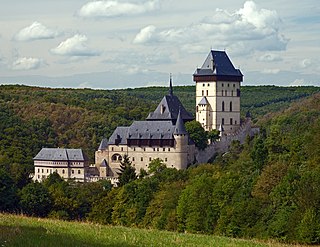
Bohemia is the westernmost and largest historical region of the Czech Republic. Bohemia can also refer to a wider area consisting of the historical Lands of the Bohemian Crown ruled by the Bohemian kings, including Moravia and Czech Silesia, in which case the smaller region is referred to as Bohemia proper as a means of distinction.

The coat of arms of the Philippines features the eight-rayed sun of the Philippines with each ray representing the eight provinces which were placed under martial law by Governor-General Ramón Blanco Sr. during the Philippine Revolution, and the three five-pointed stars representing the three major island groups of Luzon, the Visayas, and Mindanao.

The Czech lands or the Bohemian lands is a historical-geographical term which, in a historical and cultural context, denotes the three historical regions of Bohemia, Moravia, and Czech Silesia out of which Czechoslovakia, and later the Czech Republic, were formed. Together the three have formed the Czech part of Czechoslovakia since 1918, and the Czech Republic since 1 January 1993.

The coat of arms of Belgium bears a lion or, known as Leo Belgicus, as its charge. This is in accordance with article 193 of the Belgian Constitution: The Belgian nation takes red, yellow and black as colours, and as state coat of arms the Belgian lion with the motto UNITY MAKES STRENGTH. A royal decree of 17 March 1837 determines the achievement to be used in the greater and the lesser version, respectively.
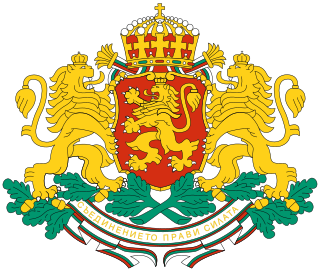
The coat of arms of Bulgaria consists of a crowned golden lion rampant over a dark red shield; above the shield is the Bulgarian historical crown. The shield is supported by two crowned golden lions rampant; below the shield there is compartment in the shape of oak twigs and white bands with the national motto "Unity makes strength" inscribed on them.

The Bohemian crown jewels, also called the Czech crown jewels, include the Crown of Saint Wenceslas, the royal orb and sceptre, the coronation vestments of the Kings of Bohemia, the gold reliquary cross, and St. Wenceslas' sword. They were originally held in Prague and Karlštejn Castle, designed in the 14th century by Matthias of Arras. Since 1791 they have been stored in St. Vitus Cathedral at Prague Castle. Reproductions of the jewels are permanently exhibited in the historical exposition at the former royal palace in the castle. The crown was made for the coronation of Charles IV in 1347, making it the fourth oldest in Europe.

The coat of arms of the Slovak Republic consists of a red (gules) shield, in early Gothic style, charged with a silver (argent) double cross standing on the middle peak of a dark blue mountain consisting of three peaks. Extremities of the cross are amplified, and its ends are concaved. The double cross is a symbol of its Christian faith and the hills represent three symbolic mountain ranges: Tatra, Fatra, and Matra.

The coat of arms of Scotland, colloquially called the Lion Rampant, is the coat of arms historically used as arms of dominion by the monarchs of the Kingdom of Scotland, and later used within the coat of arms of Great Britain and the present coat of arms of the United Kingdom. The arms consist of a red lion surrounded by a red double border decorated with fleurs-de-lis, all on a gold background. The blazon, or heraldic description, is: Or a lion rampant Gules armed and langued Azure within a double tressure flory-counter-flory of the second.
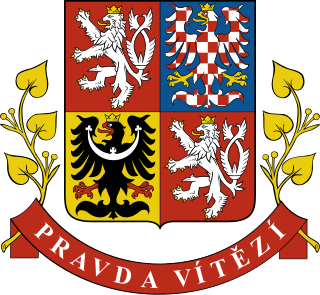
The coat of arms of the Czech Republic is divided into two principal variants. Greater coat of arms displays the three historical regions—the Czech lands—which make up the nation. Lesser coat of arms displays lone silver double-tailed lion in red shield. The current coats of arms, which was adopted in 1992, was designed by Czech heraldist Jiří Louda.

The coat of arms of Czechoslovakia were changed many times during Czechoslovakia’s history, some alongside each other. This reflects the turbulent history of the country and a wish to use appropriate territorial coats of arms.

The House of Schwarzenberg is a German (Franconian) and Czech (Bohemian) aristocratic family, formerly one of the most prominent European noble houses. The Schwarzenbergs are members of the German and Czech nobility, and they once held the rank of Princes of the Holy Roman Empire. The family belongs to the high nobility and traces its roots to the Lords of Seinsheim during the Middle Ages. The secundogeniture branch of the Schwarzenbergs was among the foremost Czech patriotic houses.

The flag of Pittsburgh is the official municipal flag of the City of Pittsburgh, Pennsylvania. It is a vertical bicolor triband of black and gold with the municipal coat of arms in the center.

Coat of arms of Tallinn represents Tallinn, the capital city of Estonia.
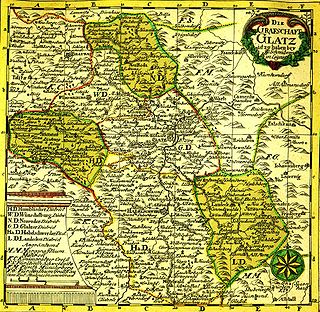
The County of Kladsko was a historical administrative unit within Bohemia as a part of the Kingdom of Bohemia and later in the Kingdom of Prussia with its capital at Kłodzko (Kladsko) on the Nysa river. The territory comprises the Kłodzko Land with the Kłodzko Valley in center within the Sudetes mountain range and roughly corresponds with the present-day Kłodzko County in the Polish Lower Silesian Voivodeship.
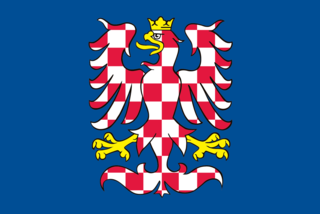
An official version of the flag of Moravia, unlike the provincial Moravian coat of arms, does not exist, because such a flag has never been granted to Moravia. However, there are several documented variants of Moravian flags used in the past. The first recorded version dates from the mid-13th century.
A national coat of arms is a symbol which denotes an independent state in the form of a heraldic achievement. While a national flag is usually used by the population at large and is flown outside and on ships, a national coat of arms is normally considered a symbol of the government or the head of state personally and tends to be used in print, on armorial ware, and as a wall decoration in official buildings. The royal arms of a monarchy, which may be identical to the national arms, are sometimes described as arms of dominion or arms of sovereignty.

The national symbols of the Czech Republic are flags, heraldry, cultural expressions and other symbols that represent the Czech Republic, Czech people and their history, culture and nationhood. There are six official symbols which are declared in the Constitution of the Czech Republic. However many other historical, cultural and geographical symbols of the Czech republic and Czech people do exist.

The coat of arms of Moravia has been used for centuries to represent Moravia, a traditional province in the present-day Czech Republic. The coat of arms is also present in a field of the coat of arms of the Czech Republic.

The coat of arms of Castile was the heraldic emblem of its monarchs. Historian Michel Pastoureau says that the original purpose of heraldic emblems and seals was to facilitate the exercise of power and the identification of the ruler, due to what they offered for achieving these aims. These symbols were associated with the kingdom, and eventually also represented the intangible nature of the national sentiment or sense of belonging to a territory.























